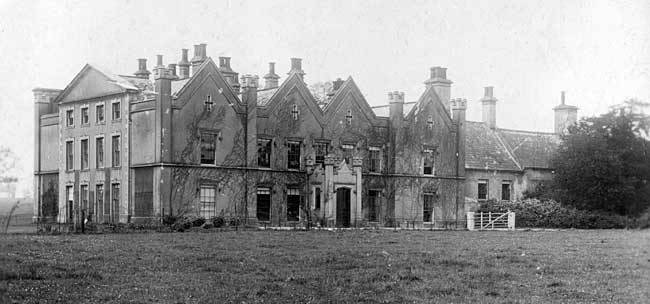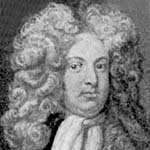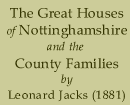< Thurgarton | Contents | Watnall >
Wallingwells

Wallingwells from the park, c.1910.
TO an edition of " Thoroton’s Nottinghamshire," which rests on the shelves of the library at Wallingwells, a painstaking member of the family residing there, has, at some time or another, made certain valuable additions in manuscript. These are extracts and compilations from deeds and other documents in Sir Thomas White’s possession, and consequently the information they contain may be described as exclusive. Turning over the closely-written leaves, which have made this particular copy of the local historian precious, I came across the following interesting extract "In the house (Wallingwells) were nine persons besides the prioress, all of good life and conversation, who desire to continue religious ; the house well reputed, and good hospitality there daily kept. The moveable goods worth £52 3s. 8d.; no debts owing to the house." Some of these characteristics, described as they are, with an almost pathetic exactness, the modern house at Wallingwells still retains; the others belongs to a past, which is ever becoming more remote. The house is still "well reputed." It is occupied by a family, whose connection with the county is of centuries long duration, and whose representatives have always been intimately associated with the administration of its affairs. It was the first titled owner of Wallingwells, who, a generation ago, in view of an invasion of these shores, voluntarily sustained the cost of the formation and maintenance of an entire volunteer force, and who firmly declined to accept a portion of this self-imposed expense from those who were perhaps better able, and who were certainly willing to bear it. His immediate successor, who has now reached the advanced age of eighty, was brought up to the profession of arms. In Nottinghamshire he was known as an ardent politician, who consistently supported the Conservative cause, as an active magistrate, and a considerate landlord. Ten years ago an untoward accident deprived Sir Thomas White of one of his limbs, and the county of the active services of one of the most influential of its magnates, but under the rule of a high-minded, warm-hearted, and intelligent owner, who lives amongst his people, Wallingwells has sustained that "good repute," which seems to have attached to it when its floors were softly trodden by the feet of holy women. But it has lost its monastic character ; there are scarcely any remaining evidences of the "good life and conversation" to which its earlier inhabitants were pledged, and the value of its "moveable goods "has increased to meet the requirements of one of the leading county families. The antiquity of Wallingwells is fully established by historic testimony, and there exists no doubt as to the purposes to which it was originally devoted. It was formerly part of the manor and parish of Carlton-in-Lindrick, until, in the reign of Stephen, a certain knight, by name Ralph de Cheurobcourt, granted "to Almighty God and the Virgin St. Mary a place in his park at Carlton-by-the-Wells, to make and build there an inhabitation for holy religion, so free that this place shall not depend on or belong to any other place." In conformity with the conditions of Sir Ralph’s generous grant, a Benedictine Nunnery was built here, and, so far as can be ascertained, the only breach of the conditions laid down by The worthy knight, was in the naming of the place, which was called Walden-de-Wells, from its situation among" wells, fountains, and streams," and from which its present nomenclature has been derived. It is more than probable that for a very considerable period Wallingwells, to adopt its most modern name, was a small centre of religious asceticism, for there is evidence that it was used as a priory many years after its foundation. Not more than fifty years ago, whilst some excavations were being made near the house, several stone coffins were brought to light, in one of which were the ashes of a prioress, who governed the nunnery in the reign of the First Richard, were found, together with a silver chalice, which, it is supposed, had been placed in the hands of the deceased Superior. The whole of these coffins were reinterred, probably to remain hidden from view for another six hundred years. In the reign of Elizabeth, we find Wallingwells in the joint possession of a leather seller and a grocer, who probably respectively made her Majesty’s boots, and supplied the Royal table with small commodities. The heirs of the leather seller made it the family residence, until the reign of Charles II., ii hen it was sold to a Major Taylor, who had been Governor of Tangier, and this family held it until it came into the possession of the Whites.

Thomas White of Tuxford and Wallingwells M.P., 1667-1732.
Thomas White, of Tuxford, who lived some two hundred years ago, was a lucky man. He was out hunting one day, and, as many a follower of the chase has done, both before and since, he lost his way. The day waned; twilight deepened into dark, and a propitious fate or a distant light, led Thomas White’s jaded horse, and his probably equally exhausted and disconsolate rider to the friendly portals of Wallingwells. At that time the house was occupied by Miss Bridget Taylor, who, besides being a great heiress, was a lady, whose personal charms, if they are fairly represented on the canvas, which I saw on Sir Thomas White’s walls, were pronounced. Mr. White found shelter and a wife; he, a gentleman of good family and considerable standing in the county, married the heiress of Wallingwells as a result of that accidental visit. But for an incident equally strange, though perhaps less romantic, an account of which I had from Sir Thomas White’s own lips, the family honours, which were bestowed upon a lineal descendant of the country gentleman who wooed and won the heiress, would probably have passed in another direction. Sir Thomas, when a boy, was with his father at Scarborough, taking part in a sport, of which the first baronet was a leading patron—hawking. Wandering by the sea-shore, with a hawk fastened to his wrist, the heir to the title and estates of the Whites was overtaken by the tide, and washed out to sea some considerable distance. The hawk having, like Stephano, a very distinct aversion to water, made such vigorous use of its powerful wings, that it dragged the drowning boy to shore, and saved his life. There is no connection between these two incidents, but each of them is extraordinary in its way, and each is in a manner associated with the history of Wallingwells, and the fortunes of its lords. The first serves to show how the Wallingwell’s property came into the hands of the Whites, who formerly resided at Tuxford, the manorial rights of which place were purchased by one of the family, in 1545. The purchaser of this estate married a sister of Lord Burleigh, Lord High Treasurer of England, and was succeeded by his son, Sir John White, Knight, who was Sheriff of Nottinghamshire in the reign of King James I. The successors of this gentleman were Members of Parliament for Retford, from 1678 downwards, and one of them is mentioned by Walpole "as an old Republican who governed both Newcastle and Lord John Cavendish."
I suppose the original priory was a much less pretentious building than that which now adorns this broad and beautiful bit of north Nottinghamshire and Yorkshire landscape. The old nunnery was never destroyed, and some of its walls still remain to form part of the present house. It overlooks a fine piece of park land, remarkable for charm of foliage and variety of aspect, and much of it is in Yorkshire. A tree which, from the library window, looks to be but a few yards away, marks the boundary line; the house is in Nottinghamshire, the greater part of the park and a large portion of the estate are in Yorkshire, and from a high piece of ground in the gardens you can see the hills of Derbyshire. Standing on the gravel outside the hall the sound of falling water comes pleasantly upon the ear. This suggests the streams and wells from which the place takes its name. The sound is associated with a grotto which stands near a small lake, whose waters are inhabited by trout and grayling. This grotto, which is of picturesque formation, is of large size and of evident antiquity. It is composed of huge blocks and greyish stone, which, arranged two hundred years ago with a kind of studied gracelessness, have remained to form a cool and desirable retreat on a hot day. The stones are of vast size, some of them, and John White, who raised the structure somewhere about two centuries back, at the cost, at any rate, of immense labour, introduced various forms of stone from the petrifying wells of Derbyshire, and made a ceiling to his picturesque summer-house of the beautiful spars and ores which were found in the mines belonging to the family in Yorkshire.
The head of a tiger, his terrible jaws open, and exposing rows of sharp and curving weapons, resting upon the extremity of the balustrade of the main staircase at Wallingwells, confronts all Sir Thomas White’s visitors. The skin of the tiger (which was shot by Colonel White in India) to the extremity of the tail is continued along the upward sloping bannister, so that the animal looks in the act of springing, and the stranger may be pardoned if he involuntarily withdraws his hand from the bell handle, and retreats from the portico with more or less precipitancy. The house is full of such trophies of the tropical chase. They have most of them been brought home by Colonel White, Sir Thomas’ eldest son. There are the tusks of elephants, the heads of ibex and bison, and birds of brilliant plumage. In an ante-room belonging to the library there is a collection of ancient weapons, amongst which is an ancient breech-loader, with the old-fashioned flint lock, which serves to prove the fallacy of a prevalent notion that breechloading guns are modern inventions. The house is a museum of curiosities. There are the handsome and costly trappings worn by the horse ridden by the first Duke of Marlborough. The trappings, which are of rich and elaborate workmanship, were used by Sir Thomas White, when, as High Sheriff of the county in 1833, he rode out to meet his Majesty’s judges on their way to open the Commission of Assize at Nottingham. General Armstrong is twice associated with the illustrious duke in the Wallingwells collection ; his daughter was married to an ancestor of Sir Thomas White’s. He was governor of the Tower of London where his ashes now lie. Bridget Taylor, the heiress, had some queer fancies. The chief of these, so far as I can make out, was an almost absorbing fondness for silver. Her toilet service was of this beautiful and precious metal, the backs of her hair brushes were of silver, and the furniture of her baby house was of silver filigree work. Locked in an antique cabinet of tortoise-shell, which stands in one of the smaller rooms at Wallingwells, is a collection of small nick-knacks which may be described as the chairs and tables of a house of dolls. They are all of silver and supposed to have been worked in Italy. They are perfect examples of miniature furniture, every detail, even to the folding of the leaves of the tables, being represented. These were part of the belongings of the heiress. Under the head of curiosities and objects of interest, I may mention one which appears amongst a collection of stuffed birds which occupies a portion of one of the corridors. It is a heron round whose neck an eel is coiled. The bird with the eel still alive was picked up from the shores of the lake near the house, and his death was readily accounted for. The heron had pierced the head of the eel with his long bill, and the snake-fish round his enemy’s neck, Locked in stiff rings of adamantine coil, strangled the bird who perished with his prey. The incident is a remarkable one, and Lady Maitland, one of Sir Thomas White’s daughters, has reproduced it in bronze. This admirable model stands on the dining room mantelpiece. Lady Maitland, besides being a clever and artistic worker in bronze, as several objects in different parts of the house testify, is an equally clever worker in marble, and perhaps the best specimen of her art is a small sculptured bust of her father.
The bibliomaniac would say that the cream of the Wallingwells heirlooms was to be found on the shelves of the library. It is a famous collection’ of old literature, some in black letter, some in manuscript. The room is filled the thoughts of past centuries; a book bound in coloured cloth would be as much out of place among that dingy fraternity as a harlequin in a synod of saints. One of these books that I chanced to look at was a tract dedicated in 1696, by a celibrated Nonconformist divine of that day, to that very heiress of whom I have spoken, exhorting her not to put her trust in riches, but rather, I suppose, in Nonconformist divines. Lady Mildmay’s "Lesson of Heaven and Earth," written in manuscript forty years earlier, contained no doubt some valuable prescriptions for mending spiritual weakness. The pictures at Wallingwells are interesting, because they serve to tell the family history. A portrait of Sir Ralph Knight in the dining room suggests that the well-known family of which he was a distinguished representative, had some connection with the Whites, and calls for an enquiry which leads to the information that some of the Yorkshire part of the Wallingwehls estate passed from the hands of Mr. Gaily Knight into those of its present owner. In the same room there is a representation of the first Duke of Marlborough, whose horse wears the very gold and crimson trappings which were worn by Sir Thomas White as High Sheriff of the county nearly half a century ago, and which have only seen daylight on rare occasions since. In another part of the house the same warrior noble is presented by Sir Godfrey Kneller, who painted the double portrait—for the duke and his faithful general appear on the same canvas—in fulfilment of a special commission. There are, I think, in different parts of the house, three portraits of the first of the Churchills who held the rank of duke, and in two of them General Armstrong is introduced. As I have said the daughter of this illustrious soldier was married to an ancestor of Sir Thomas White’s, a fact which will, perhaps, account for the presence of these pictures in the Wallingwells collection. Among the other portraits are a couple representing Sir Peter Lely’s best style, portraits of Miss Jenny Deering, afterwards Lady Ogle, and Lady Casthemaine; a portrait of Miss Bridget Taylor, the heiress who was so fond of silver; one of Lady St. Aubin, and a number of family likenesses in oils. Besides these, what may be described as family pictures, there are a few good paintings,—landscapes, seascapes, and others, by masters, and in the dining room there are three large pictures by Paillou, an artist of some repute about a century ago. There is much that is interesting in the halls of this old county family who owned an estate at Cotgrave before their untitled ancestor purchased the manor of Tuxford, and took up his residence there more than three hundred years ago. It is pleasant to hear from the lips of the surviving head of that family, that one is welcome to examine the treasures of cabinet, gallery, and library, or to wander at will about the well-kept walks of a pleasant and well-ordered garden. Under some circumstances one would be inclined to tarry long ; to take a seat in that still old library, and in the soft light of a May evening to imbibe the wisdom of the medieval scribes ; to examine more closely the articles of virtu in the drawing room where the is a handsome sandal wood cabinet full of quaint little trinkets, and to read a letter which was written by the Rajah of Cashere to Colonel White, when that gallant officer commanded the 16th Lancers, but time presses, and one can only take a cursory glance at these several objects of interest.
< Thurgarton | Contents | Watnall >
